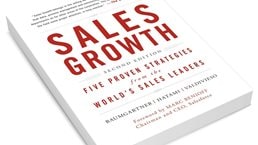Few business leaders would dispute the fact that sales teams must evolve. They are already investing billions of dollars in sales technology and training in response to automation and artificial intelligence, which are making ever deeper inroads into the sales function.
Stay current on your favorite topics
The trouble is that these investments aren’t paying off. We speak with many sales leaders who are frustrated with the lack of clarity on the ROI of their investments and surprised when their new “shiny toys” (such as a new lead-generating tool) fail to deliver meaningful performance improvement.
The truth is that driving sales growth today requires fundamentally different ways of working as well as outstanding execution across large, decentralized sales teams and channel partners. While many sales leaders accept this reality in principle, they don’t put sufficient energy or focus into driving that level of change. Advances in digital and analytics, however, mean that sales leaders can now drive and scale meaningful changes that pay off today and tomorrow.
Companies that get this right typically see 5 to 10 percent revenue growth with the same or improved margins. And they see many of those benefits quickly, often within a few months. In addition, their longer-term health, as measured by better customer and employee satisfaction, improves.
The four ways digital and analytics drive successful change
Digital and analytics can radically accelerate—and improve the chances of delivering—successful change. But undisciplined investment can be counterproductive and expensive. In our experience working with companies that have successfully boosted the ROI of their sales investments, these four actions make a meaningful difference:
1. Provide insights that sales reps need
A wealth of sales insights are discoverable today through advanced analytics, but they often don’t translate into sustainable revenue for a few reasons: the front line does not trust the data, the insights are overly complex, or reps simply feel that their own experience and expertise are being ignored. Successful change programs rely on a deep understanding of the needs of the salespeople and a willingness to work back from there to deliver insights that actually help reps sell better. The best sales organizations use data to understand the effect of all the steps in sales, from what matters most in driving a sales opportunity forward to where reps struggle or miss opportunities. They then package those insights and send them to sales reps. Actively involving sales reps in the process greatly increases the chances of providing relevant and easy-to-use solutions.
Car manufacturers offer an excellent example of how to manage frontline needs. Their dealer networks are often quite autonomous (stocking and product-configuration decisions are made by individual dealers). This means, for example, that having 2,000 dealers in a given market equates to 2,000 separate decisions on what stock to take. Traditionally, there has been little attempt to use data from the entire dealer network to optimize those decisions. As part of a shift to optimize and upgrade the stock at its dealerships, one manufacturer aggregated data on specific car configurations (engine type, trim, color, etc.) purchased across the network. It then calculated the optimum mix of stock based on a combination of profitability and customer appeal, which could be updated in real time as sales were made.
The insights were played back to each dealer, to speed up the process and make them better informed, with specific recommendations on which cars to order. What was fascinating was the degree of uptake of the new system. The adoption rate within nine months was 80 percent, a striking contrast to a previous effort where the adoption rate was below 10 percent. Cars spent far less time in the showroom before being bought, heterogeneity of vehicles increased (which helped with residual values), and the contribution margin grew by more than 10 percent.
What changed? The first time around, the company had been clear on what the outcome needed to be, but it hadn’t taken the individual dealers’ perspective into account. The dealers resisted what felt like a top-down idea imposed on them, because they didn’t really understand the benefits, and implementation was difficult. This time, the digital tools that delivered the insights were built hand-in-hand with the dealers from the outset, to understand what functionality and information was most helpful for them. The manufacturer also used an agile approach to development, refining the tool quickly based on real dealer feedback. The dealers were engaged in the process, understood what the company was trying to achieve, and recognized it would make their lives easier. As uptake was so high, the impact for the company was also high.
Would you like to learn more about our Marketing & Sales practice?
When done well, this approach can also empower the sales force. As part of a sales transformation focusing on pricing and growth, a chemicals company used analytical tools that gave the field sales force transparency on the overall business, which encouraged and enabled them to create their own strategies and implementation plans. They could create their own projects on the platform, which of course could be tracked by managers, and the impact was impressive: within just a few weeks of implementation, churn was down and pricing was up, and within a year, it contributed an additional $50 million to EBITDA. The magic was the combination of getting insights to the front line in a simple, easy-to-digest way while allowing reps the freedom to explore some of the underlying input, which let them develop their own ideas.
2. Use digital to enable what matters for each sales rep
We often find companies that have excellent operational discipline but fail to apply a similar rigor to sales. They seem to linger under the misunderstanding that sales is all about relationships or that sales teams are motivated solely by incentives.
The core elements in enabling effective sales operations are focusing reps’ time and attention on the handful of metrics that disproportionately matter. Those often include the size of the pipeline and conversion rate, and incentives that are consistent with the company’s overall vision for its transformation, rather than those based on out-of-date ideas or on criteria beyond the sales rep’s control. Embedding weekly routines and daily expectations of activities reinforces the ultimate goal of driving sales growth. Crucially, then, sales leaders need to focus on digital and analytics capabilities that deliver on these needs.
A technology company had limited data on sales, margins, and products sold at the rep level, and no performance-management systems. When it attempted a large transformation that involved capturing new growth, realigning coverage to match opportunities, building frontline capabilities, and redesigning compensation structures, results were slow to arrive—and quarterly-target pressure did not let up.
The company realized it needed to use analytics and an automated report system to create dashboards personalized for each salesperson and highlight the opportunities they needed to follow-up on.
Reps now see their top opportunities on a daily basis, which helps them prioritize their actions.
The techniques were also used to help sales support staff drive the most efficient selling process. Pricing specialists were flagged on where the hottest opportunities were and also on opportunities to cross-sell with their customers.
Importantly, from a performance-management perspective, the dashboard also introduced transparency. Managers all the way to the C-suite could now identify the best-performing reps and what opportunities they had closed, and where reps needed coaching. It worked both ways. Reps could also flag where they needed help, all the way to the C-suite, which ensured that priority opportunities got the right level of attention.
The combination of reporting, enablement, and coaching delivered an enormous impact very quickly: a $55 million uptick in revenues for that quarter using “quick and dirty” tools effectively rather than making enormous investments. The trick was making the information available at the individual level.
Using digital tools is necessary to scale solutions across the sales organization. That includes creating tailored dashboards for all sales personnel as well as decisioning tools to help reps in the field make better decisions. These don’t need to be overly complex; even quick and dirty solutions can deliver profitable results without waiting for more sophisticated IT investment and development.
One software company turned to digital to crack a recurring problem: the sales force was so fragmented and dispersed that it was hard to know whom to call for help. There were more than two dozen sales roles within the function, from account managers to software architects, and the company realized that the right people were seldomly working on the right deals. It developed a digital tool to embed within the CRM system that could give sales reps the precise names of the right people to call for any particular deal—there could be as many as ten at any one time—based on their specific experiences. This tool also scrapes email and calendar data to understand what patterns of sales-staff interaction are most highly correlated with strong performance: How often do they interact, at what stage of the deal, and which specific combinations of people work well in which situations? Ultimately, the company has recognized the power of collaboration and is using data and analytics to change the behavior of thousands of sales reps, guiding them to better outcomes.

Sales growth: Five proven strategies from the world’s sales leaders (2nd edition)
3. Use data to prioritize and personalize capability building
Best-in-class sales organizations place an enormous emphasis on building frontline capabilities during a transformation; this applies to their own sales force and channel partners. They recognize that otherwise there is no hope of any new tool or new approach delivering results. But they don’t stop there. These sales leaders use analytics to get very specific on what skills to teach and to whom in order to reengineer the very DNA of the sales organization.
By using analytics to identify the traits and skills of top performers, it becomes clear where everyone’s gaps are. Then digital tools can be deployed alongside more traditional learning mechanisms to effectively roll out coaching to large and widely distributed sales forces.
The technology company above understood that building frontline skills was the key to a successful and sustainable transformation. But with so many new skills needed, they struggled with prioritizing them. Sales leaders turned to analytics. Our analysis (based on our Sales DNA database on sales rep performance) revealed that although pipeline management was an important skill, it was also one that the organization was already quite good at. The data also showed that top performers were much better at understanding the customer needs and quantifying the value proposition being delivered.
Once the company knew which skills to prioritize, it used multiple formats to deliver the training. First, the company reinforced key concepts through e-learning modules that then were applied in daily routines. These modules included interactive elements and videos from experts on subjects such as how to tailor a value proposition, which reps could then practice on the job.
Second, frontline sales staff had to record their own value-proposition delivery, or elevator pitch, using a digital platform that allowed managers to observe sellers and their behaviors. These mini-testimonials were then benchmarked by assessors and the top performers’ pitches were disseminated to highlight best practices. Managers did their own assessment of the videos but were also flagged on where there were important gaps so that they could provide coaching. The new approach delivered a 5 percent quarter-on-quarter sales increase for those reps whose skills demonstrably improved.
There are times when digital tools have to take a backseat to more traditional training methods. At the chemical company mentioned earlier, much of the training was done using the new data-driven tool, but a huge amount of work had to be done by the sales managers in weekly one-on-one meetings. Managers need to devote significant time and attention to teaching reps about the business and imparting critical-thinking skills so reps can understand what the data are showing and tailor it appropriately.
4. Communicate, communicate, communicate
Sales leaders need to set out bold vision based on where the opportunities for growth lie, but then they need to make that personal for each seller and manager. Advanced analytics can help set granular targets and personalize those targets to each individual region, manager, and seller.
Some of the digital tools that B2C companies use to personalize the customer journey and change consumer behavior can be used very effectively to communicate changes to each individual in the sales organization. Specific tools that work well include shared dashboards, visualizations of activity across the team, “gamification” to bolster competition, and online forums where people can easily speak to one another.
Leading companies also make sure they demonstrate progress, using analytics to communicate real-time insights and share early wins. More sophisticated tools can even show individual contributions toward the common goal, which can be very motivating. Overall, this sort of communication makes the change feel more urgent and real, which in turn creates momentum.
A large technology company uses an incredibly data-rich scorecard fed by data from across the sales organization. It tracks up to 50 metrics, which are updated daily and fed into leadership meetings on a weekly basis so managers can see what’s working and what’s not and adjust course accordingly, feeding insights back to the front lines for rapid realignment where necessary.
Digital tools and analytics insights, if correctly applied, offer a powerful way to accelerate and amplify a sales organization’s capacity to grow. However, let’s be clear: the tool should not drive the solution. Each company should have a view of the new behavior it wants to reinforce and design a practical, integrated approach to leverage digital and analytics.


